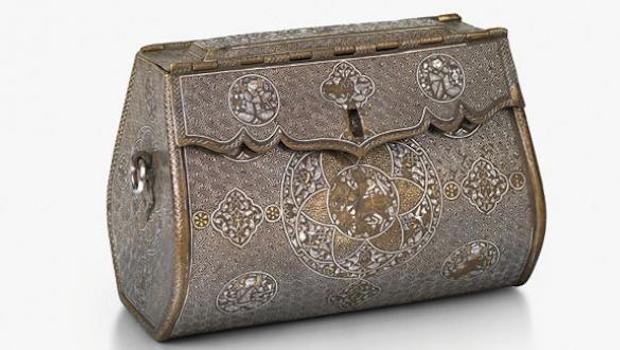
Bag, Mosul, Northern Iraq, 1300-1330
Brass, inlaid with gold and silver
© The Courtauld Gallery, London
London, Asharq Al-Awsat—This handbag, currently on display at the Courtauld Gallery in London as part of its “Court and Craft” exhibition, holds a special place in history and is part of the first exhibition of its kind in the field of Islamic art at the distinguished gallery.
The exhibition is also notable in that it revolves around this one unique item, a handbag made of brass, inlaid with silver and gold and dating from around 1300 CE. On its cover is an engraved scene of a royal celebration, showing a man and a woman surrounded by a crowd that includes musicians and a man holding a hawk.
This marvelous piece is a testament to the precision and craftsmanship in Iraq at the time it was made. The bag’s original purpose is unclear, but the Courtauld’s explanation of its provenance is convincing.
According to the exhibition’s organizer, Rachel Ward, the handbag was made in Mosul, northern Iraq. Calling such an extraordinary work of art a handbag seems strange, but Ward is keen to defend the theory.
She told Asharq Al-Awsat: “We are convinced that it is a ladies’ handbag despite the fact it was classified differently in the past.”
In the Victorian era, an antique collector named Thomas Gambier Perry bought the bag during a trip to Venice in 1858. His grandson donated the bag to the Courtauld Gallery in 1966, when it was classified either as a document case or a saddlebag. But in this exhibition, the gallery is promoting the argument that it was a handbag owned by a lady of the ruling elite in the Ilkhanid state founded by Genghis Khan.
The faces of the elite in the scene engraved on the bag’s face are probably those of Mongols, a conclusion Ward says can be drawn from their “round faces and short noses.” In contrast, “the images of the musicians are much more Arab,” she says.
In the seven centuries since it was made it has been modified to suit the needs of its different owners. “At one point later in its history in Europe I can say it was adapted into a locker box—that is why we see a rectangular hole on the center top” says Ward.
Alongside this enigmatic purse in the exhibition is a large painting resembling the scene engraved on the top of the handbag that reveals details not visible on the bag itself.
“The scene is recognizable as a court scene, because we have other documents with similar scenes,” Ward explains.
She added that the woman in the scene was a royal: “We don’t know for sure, but it is most likely, partly because it is splendid and partly because in all the surviving scenes of women with bags they were actually royal—not to say that there weren’t other grand women with bags, but I would say this one is royal.”
Although “Court and Craft” centers around this handbag, also included in the exhibition are several documents, drawings and metal fragments with similar features and dating from around the same time. That includes 40 items borrowed from institutions such as the British Museum, the Victoria & Albert Museum and the David Khalili Collection. Each has been specially chosen to tie in with the features of the handbag, whether through the medium of brass metalwork, calligraphy or painting.
Court and Craft runs at the Courtauld Gallery, London, until May 18, 2014.
